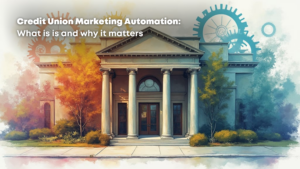Marketing automation is standard for many industries, but credit unions are only just getting started with it. Unfortunately, this means that many credit union marketers can’t visualize the benefits.
One of the key abilities of the technology is the automated nurturing sequence. Let’s look at what it is, how it works, and what it looks like.
What Is an Automated Nurturing Sequence?
A nurturing sequence is a specific form of marketing outreach usually conducted through email. Essentially, it’s a series of 3–7 emails designed to educate someone about a product.
Nurturing sequences should loosely follow the buyer’s journey. So, most of them start off with high-level information. Subsequent emails continue to inform as the buyer narrows down options. The final email might end with an offer or promotion.
Not all nurturing sequences are alike! Many are shorter. Some are longer. Often, a final reminder email comes a couple weeks after the strong call to action (CTA)—it’s just a friendly reminder that the offer is still on the table if they’re interested.
How Do Nurturing Sequences Work for Credit Unions?
The first thing you need for a successful nurturing campaign is contact information. It’s easy to nurture members—you already have their info. But if a site visitor isn’t a member yet, you’ll need to get at least their name and email address before you start.
(You’ll probably need to use a form in your automation platform.)
Nurturing sequences start off with triggers. Examples of triggers include things like:
- When a visitor fills out an online form
- If a lead requests more information
- When a member visits a landing page or high-value content
After a site visitor performs one of those actions, you can build an outreach sequence. The automation platform will email the lead periodically to educate, inspire, and suggest solutions related to the trigger.
Ultimately, it should lead them to make a decision (to use your product or service).
What a Nurturing Sequence Looks Like
The visual workflows in a marketing automation platform take up a lot of space. So, instead of a picture, we’ll describe an example sequence.
In this example, we’ll say that the credit union has content related to auto loans and car buying. Those pieces of content include:
- A landing page for auto loans
- An infographic about leasing vs buying
- A blog about buying used vs new
- A blog about how to get the best deal on a car (time of month or year, risks, loan rates, etc.)
- A calculator showing how much car a member can afford—and how to apply for a loan
You’ll need to choose several pieces of content from this list. Then, you’ll have to arrange them in an order that loosely mirrors the car buyer’s journey.
Auto Loan Nurture Campaign
The first thing you’ll need to do is set up triggers. Let’s say you have a trigger set up for every piece of content listed above. You can immediately start an automated nurturing sequence for car loans when a member visits one of the above pieces of content.
Your sequence might go something like this:
1. Intro email
Your first email should be a friendly greeting. You’re reaching out to see if someone needs help navigating a car purchase.
To get started, you might share a calculator showing how much car a member can afford. If they’re early in the car buying process, this will help them narrow down what they should realistically look for.
Plus, it contains a little information about how to apply for an auto loan. If they’re farther along in their car buying journey, they may be ready to buy already.
2. Second email
Your second email should flow naturally from the first. Now that they know how much car they can afford, what would they want to know?
Now is your opportunity to continue to inform and educate. You might send an infographic about buying vs leasing. This will help them narrow down their options further.
3. Third email
In your third email, you might want to continue the theme and send a blog about buying new vs used.
If these second and third emails seem similar to you, you could combine the two CTAs into one email message. As a bonus, the automation platform will see which CTA the member clicks on, which tells you more about what kind of car they’re looking for.
4. Fourth email
By the fourth email in a nurturing sequence, you can assume that the member knows what they’re looking for. At this point, they’re probably looking for details about how best to buy.
Send them a blog about how to get the best deal on a car. It could suggest the best times of month or year to buy, what risks to look out for, and how to get the best financing.
5. Fifth email
By now, the member is probably ready to buy a car. They know all the basics:
- What they can afford
- Whether they’re buying or leasing
- If they’re purchasing new or used
- How to get the best deal
All that’s left is to actually buy the car. You’ve already helped them through several steps of the buying journey, so it’s time to offer one last bit of help.
Send them to your landing page for auto loans.
How It All Comes Together
Each email should follow a similar format:
First, craft a short, compelling subject line.
Second, introduce the subject at hand—in this case, how to buy a car. Provide some brief context for your email. (Hint: you’re trying to make their lives easier.)
Third, include an informative CTA that will help the member get what they want. (A car, of course.)
Fourth, throw in whatever sign-off feels right. Consider hyperlinking to your landing page toward the end of each email. It shouldn’t compete with the primary CTA, but many people speed through the buying process, and you wouldn’t want to make your offer too late.
Each email you send does double duty. It informs and assists your members in their buying journey, for one. But it also keeps you top of mind when it comes to financing.
Think about it. If a company spends the time and effort to properly educate and guide you through your shopping and buying process, won’t that build trust? And wouldn’t you see if they could help you buy, too?
Final Thoughts
Credit unions can build numerous nurturing sequences in their marketing automation platforms. All they need is a product and some content related to it. For example, instead of auto loans, you might want to try:
- Home improvement loans
- Secured credit cards
- Money market accounts
- Onboarding guidance
Your email outreach should be more about educating and advising than marketing. The ultimate goal is to create great member experiences. The car loans are just the cherry on top. (A really big cherry.)
So, if your credit union uses marketing automation and content marketing, then you have some fantastic opportunities ahead of you!
If you don’t (yet), we’re happy to help you get started.




